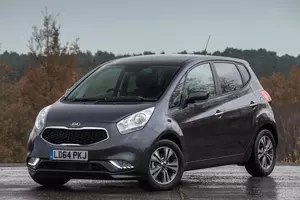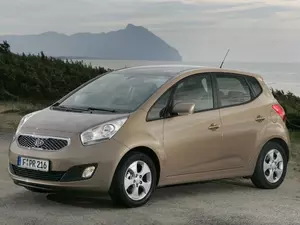
| Vehicle | Curb weight | Difference from world's smallest | Weight to power ratio | 0—60 mph acceleration ratio | Consumption ratio |
|---|---|---|---|---|---|
| 1.4 |
1178 kg / 2597 lbs |
753 kg (1660 lbs) heavier | 13 kg to 1 hp | 97 kg/s (214 lbs/s) |
196 kg/L (432 lbs/L) |
| 1.6 |
1222 kg / 2695 lbs |
797 kg (1758 lbs) heavier | 10 kg to 1 hp | 105 kg/s (232 lbs/s) |
188 kg/L (415 lbs/L) |
| 1.6 CRDI |
1281 kg / 2825 lbs |
856 kg (1888 lbs) heavier | 10 kg to 1 hp | 122 kg/s (269 lbs/s) |
285 kg/L (628 lbs/L) |
| Vehicle | 1.4 |
|---|---|
| Curb weight |
1178 kg / 2597 lbs |
| Difference from world's smallest | 753 kg (753 lbs) heavier |
| Weight to power ratio | 13 kg to 1 hp |
| 0—60 mph acceleration ratio | 97 kg/s (214 lbs/s) |
| Consumption ratio |
196 kg/L (432 lbs/L) |
| Vehicle | 1.6 |
| Curb weight |
1222 kg / 2695 lbs |
| Difference from world's smallest | 797 kg (797 lbs) heavier |
| Weight to power ratio | 10 kg to 1 hp |
| 0—60 mph acceleration ratio | 105 kg/s (232 lbs/s) |
| Consumption ratio |
188 kg/L (415 lbs/L) |
| Vehicle | 1.6 CRDI |
| Curb weight |
1281 kg / 2825 lbs |
| Difference from world's smallest | 856 kg (856 lbs) heavier |
| Weight to power ratio | 10 kg to 1 hp |
| 0—60 mph acceleration ratio | 122 kg/s (269 lbs/s) |
| Consumption ratio |
285 kg/L (628 lbs/L) |

| Vehicle | Curb weight | Difference from world's smallest | Weight to power ratio | 0—60 mph acceleration ratio | Consumption ratio |
|---|---|---|---|---|---|
| 1.6 16V |
1280 kg / 2822 lbs |
855 kg (1885 lbs) heavier | 10 kg to 1 hp | 123 kg/s (271 lbs/s) |
191 kg/L (421 lbs/L) |
| 1.4 16V |
1268 kg / 2796 lbs |
843 kg (1859 lbs) heavier | 14 kg to 1 hp | 103 kg/s (227 lbs/s) |
205 kg/L (452 lbs/L) |
| 1.4 CRDI 16V |
1370 kg / 3021 lbs |
945 kg (2084 lbs) heavier | 15 kg to 1 hp | 99 kg/s (218 lbs/s) |
291 kg/L (642 lbs/L) |
| 1.6 CRDI 16V |
1380 kg / 3043 lbs |
955 kg (2106 lbs) heavier | 11 kg to 1 hp | 131 kg/s (289 lbs/s) |
282 kg/L (622 lbs/L) |
| 1.6 16V CVVT |
1294 kg / 2853 lbs |
869 kg (1916 lbs) heavier | 10 kg to 1 hp | 112 kg/s (247 lbs/s) |
185 kg/L (408 lbs/L) |
| Vehicle | 1.6 16V |
|---|---|
| Curb weight |
1280 kg / 2822 lbs |
| Difference from world's smallest | 855 kg (855 lbs) heavier |
| Weight to power ratio | 10 kg to 1 hp |
| 0—60 mph acceleration ratio | 123 kg/s (271 lbs/s) |
| Consumption ratio |
191 kg/L (421 lbs/L) |
| Vehicle | 1.4 16V |
| Curb weight |
1268 kg / 2796 lbs |
| Difference from world's smallest | 843 kg (843 lbs) heavier |
| Weight to power ratio | 14 kg to 1 hp |
| 0—60 mph acceleration ratio | 103 kg/s (227 lbs/s) |
| Consumption ratio |
205 kg/L (452 lbs/L) |
| Vehicle | 1.4 CRDI 16V |
| Curb weight |
1370 kg / 3021 lbs |
| Difference from world's smallest | 945 kg (945 lbs) heavier |
| Weight to power ratio | 15 kg to 1 hp |
| 0—60 mph acceleration ratio | 99 kg/s (218 lbs/s) |
| Consumption ratio |
291 kg/L (642 lbs/L) |
| Vehicle | 1.6 CRDI 16V |
| Curb weight |
1380 kg / 3043 lbs |
| Difference from world's smallest | 955 kg (955 lbs) heavier |
| Weight to power ratio | 11 kg to 1 hp |
| 0—60 mph acceleration ratio | 131 kg/s (289 lbs/s) |
| Consumption ratio |
282 kg/L (622 lbs/L) |
| Vehicle | 1.6 16V CVVT |
| Curb weight |
1294 kg / 2853 lbs |
| Difference from world's smallest | 869 kg (869 lbs) heavier |
| Weight to power ratio | 10 kg to 1 hp |
| 0—60 mph acceleration ratio | 112 kg/s (247 lbs/s) |
| Consumption ratio |
185 kg/L (408 lbs/L) |